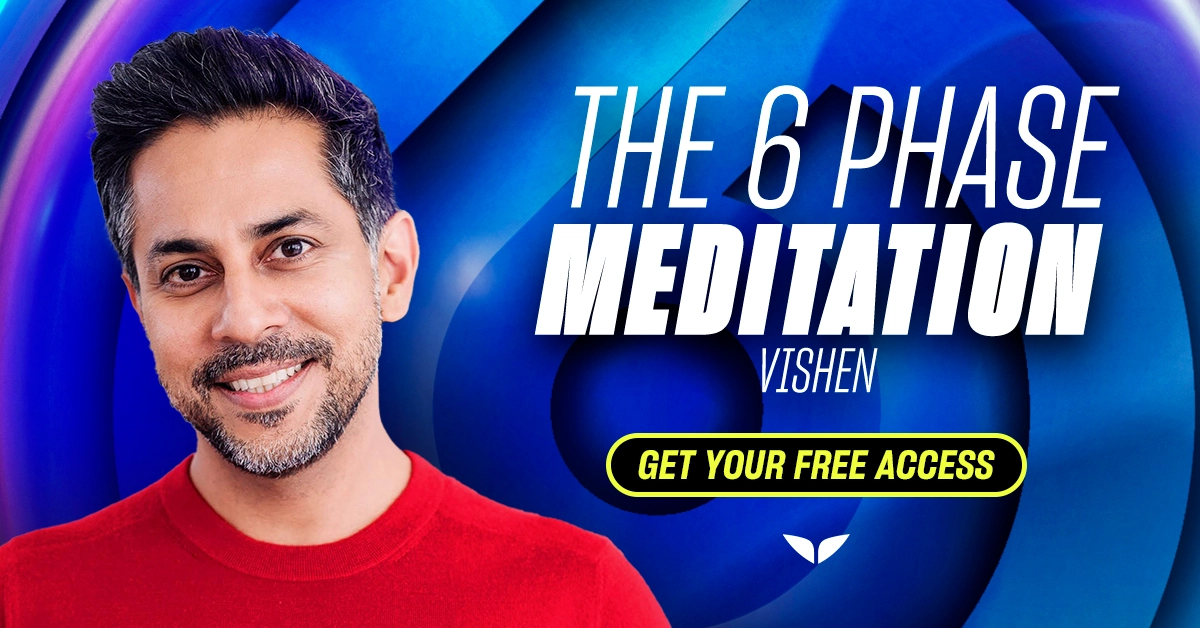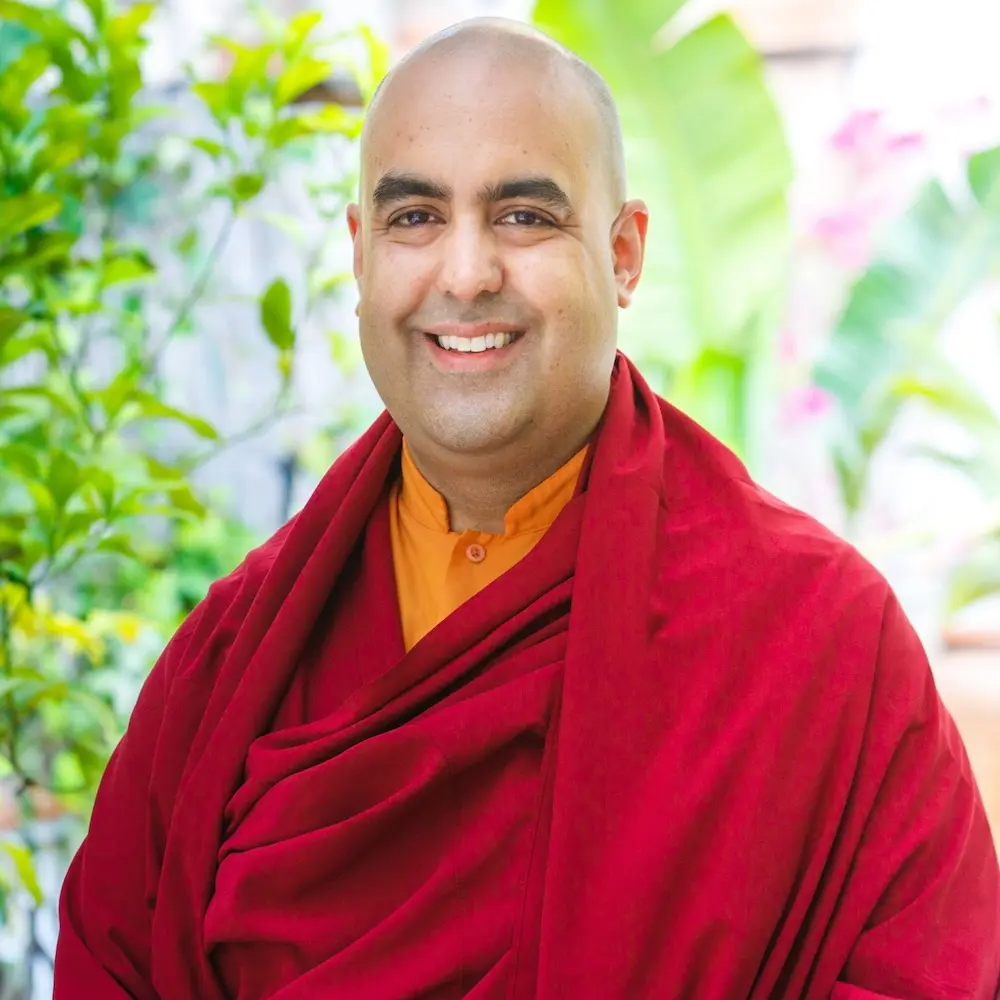The pace of modern life often leaves little room to pause. Information moves fast, and expectations build quietly. Other people’s stories and struggles pass through your awareness before you have time to notice your own.
No wonder it’s so easy to lose focus. Amidst it all, the mind starts to pull in on itself.
Your negative thoughts would loop. Mundane moments take more space than they need to in your head. And compassion, the quality that helps you stay open to others, becomes harder to reach, even when it matters most.
In moments like these, compassion meditation can offer you a quiet counterpoint. It creates space to notice what’s happening without adding force or judgment. From this place, you get to recenter, and your inherent capacity to care comes back online.
What is compassion meditation?
Compassion meditation is a practice that invites and teaches you to notice your life experiences with gentle kindness rather than pressure. It helps you develop radical self-awareness and non-judgment, which is why so many people turn to it when life turns topsy-turvy.
“Practicing meditation itself,” says Gelong Thubten, a modern monk and meditation expert behind Mindvalley’s Becoming More Loving program, “creates compassion, creates love, builds love, builds kindness.”
He explains that this happens for a simple reason. “When you meditate, there is a relationship with your thoughts, and that is the key point.”
A session of compassion meditation often involves:
- Visualizing someone you care about,
- Repeating simple phrases of goodwill,
- Holding your breath with gentle awareness, or
- All of the above.
Different traditions offer their own spin on this approach. Buddhism’s loving-kindness meditation (or metta, as Sanskrit would have it) speaks of warm regard for all beings. In Hinduism, karuṇā is all about being compassionately present. Tonglen, a Tibetan equivalent of compassion meditation, focuses on “breathing in” another’s difficulty and offering relief on the out-breath.
Each path carries its own history. Yet, they all invite a similar shift: to be gentle with yourself and others, especially in the hard moments laced with self-doubt.
Practicing meditation itself creates compassion, creates love, builds love, builds kindness.
— Gelong Thubten, trainer of Becoming More Loving on Mindvalley
Why compassion matters more than ever today
In any given day, we’re exposed to deep suffering, beyond our own, without ever leaving our chairs. War footage, personal loss, outrage, or despair easily dominate our attention thanks to social media feeds and nonstop news cycles, powered by algorithm-driven systems and the might of artificial intelligence (AI).
All this comes at a cost: a constantly overwhelmed human nervous system, stuck in fight-or-flight mode.
Emma Seppälä, the science director at Stanford University’s Center for Compassion and Altruism Research, spent years studying this phenomenon. Her research often shows that when stress builds faster than the body can recover, people begin to emotionally pull back. What appears to be apathy usually reflects a nervous system trying to protect itself.
But here’s where love and compassion meditation make all the difference. As revealed through studies she co-authored, these practices can help the body recover from stress and support a steadier, more connected response to life.
Neuroscientist Helen Weng reached a similar conclusion. The researcher stationed at the University of Wisconsin’s Center for Healthy Minds found that compassion meditation strengthens the brain’s ability to connect and respond with care, rather than shut down. This, in turn, helps people stay emotionally engaged, even amidst stress, without tipping into burnout.
No wonder Vishen, the founder and CEO of Mindvalley, makes compassion the first cornerstone of The 6 Phase Meditation. It heals and transforms not just how you relate to yourself, but also to others.
“Compassion,” he says, “is expressing the intention of moving from judgment to caring, from isolation to connection, from indifference or dislike to understanding.”
And this transformative quality? It helps you more than you realize.
Compassion vs. self-compassion meditation
Compassion meditation usually starts by directing care toward someone else or toward life around you. Over time, that same sense of care trickles back towards you.
Meanwhile, self-compassion meditation stays focused on your own experience, especially how you respond when things feel hard or uncomfortable.
Here’s a deeper look at them, side by side:
| Aspect | Compassion meditation | Self-compassion meditation |
| Primary focus | You offer care towards others or the outer environment first before yourself | You offer care to yourself |
| Starting point | Another person, a group, or all beings | Your own thoughts, emotions, and struggles |
| Core intention | To cultivate warmth, understanding, and goodwill | To cultivate gentle self-acceptance and forgiveness |
| Emotional training | Staying open to suffering without turning away | Meeting adversity without self-criticism |
| Common practices | Long-kindness phrases (similar to mantra meditation), creative visualization | Supportive self-talk, soothing attention, grounding |
| Inner effect over time | A sense of connection and shared humanity | Greater emotional resilience and inner safety |
| Relationship to the self | Compassion eventually turns inwards | Compassion begins inward and deepens further |
You can see how the two approaches emphasize slightly different ways and with different nuances. Yet they both share the same foundation: to empower your inner capacity for all-blazing compassion that’s already inherent in you.
Through meditation, that capacity becomes easier to access in everyday moments. It begins to guide how decisions are made, how challenges are approached, and where attention naturally settles.
Instead of trying to fix yourself, you start to soften. From there, you respond from a quiet peace that’s already within you, and it shows up as steadiness and care for others.
That’s what Gelong is pointing to when he says, “Our minds already contain everything we want. We just forget to look.”
The scientific benefits of compassion meditation
At first glance, it’s something you do purely for others. But the science behind why it’s good tells a more personal story. Training the mind to gently meet suffering with care, instead of resisting it, can benefit you in more ways than one:
- The nervous system recovers from stress more efficiently. No wonder musician and Mindvalley member Samir Shah could stay relaxed and more understanding of others in his day-to-day work experience.
- Your emotional resilience strengthens over time. From here, it’s easier to be less reactive and stay grounded during stressful moments.
- Connection with others feels safer and more natural. It sounds exactly like the effect that Mindvalley member Francia Saenz experienced. Having practiced Vishen’s meditation guidance, she eventually became more aware of the people who quietly shape her daily life, from strangers to family members who directly and indirectly affect her life.
- Your relationship with your own thoughts becomes less adversarial. Instead of judging or suppressing mental activity, you get to meet thoughts with acceptance, which reduces inner conflict and mental fatigue.
- Kindness translates into real-world action, like greater generosity and willingness to help others, even in the face of high-stakes situations. For John Piwoski, a sales manager and Mindvalley member, this kind of steadiness showed up as staying grounded and offering constant encouragement to his wife as she battles cancer.
“Happiness is a trainable skill,” as Gelong points out. And these shifts are proof that the “loving-kindness” route is ultimately the most fruitful way to live life.
3 compassion meditation scripts
There are small pauses built into the day—between meetings, late at night, or even sitting in a car before moving on. They don’t always feel important, but they can be natural places to take a minute and check in with yourself.
A self-compassion guided meditation script works well in those spaces.
The following options are simple on purpose. You can use them as written or adjust the wording to suit your needs, so your session feels more natural and lived in for you.
What matters is the intention behind them and the quality of attention you bring to the moment.
A short compassion meditation
Find a comfortable seat, and let your body settle down.
Now, close your eyes and focus on your breath. Pay attention to how it ebbs and flows. Allow it to move naturally without forcing anything.
As you breathe, gently bring to mind the idea that suffering exists—in you and in others.
Silently repeat the following phrases:
“May there be less suffering.”
“May there be more ease.”
“May kindness meet me and everyone around me at this moment.”
If your mind wanders, notice it and return to the breath and the phrase.
Stay here for a few minutes, then slowly open your eyes and re-enter your present day.
A self-compassion meditation
Sit comfortably and place one hand over your heart or anywhere that feels grounding.
Take a few slow breaths—nice and easy. Feel your body soften in this moment.
Now, bring to mind something that feels difficult to tackle right now. a conversation you’ve been avoiding, a mistake that keeps replaying in your head, a deadline that feels heavy, or the quiet pressure you’ve been feeling from it all.
Without over-analyzing the situation, silently offer yourself:
“This is hard right now, and that’s okay.”
“I’m allowed to feel this.”
“I am kind to myself in this moment.”
Let the words land gently. If you feel resistance in your body, acknowledge it… then continue to be gentle with yourself until you’re settled in.
Then, offer your thanks to yourself and the world.
A love and compassion meditation
Begin by settling into your breath and allowing your body to relax.
Then, think about someone you care about, someone whose presence feels supportive or warm. It can be your parent, your kid, the neighbor you love to greet every day, or your favorite colleague at work. Anyone that matters.
Then, silently repeat phrases like,
“May you be safe.”
“I wish you well.”
“May easiness find you whenever you need it.”
Repeat this for a few rounds.
After a few minutes, expand this intention outward to include others in your life that you’re not necessarily close to. Then, extend this kindness to people you don’t know… and eventually all beings.
Let the sense of goodwill move naturally, without forcing emotion or imagery.
How to practice compassion meditation: what to expect and what to avoid
Compassion meditation sounds gentle. In practice, it can feel unexpectedly confronting.
Both Vishen and Gelong are clear about this. The work is not about chasing a pleasant state, but rather, about how you relate to whatever shows up.
What to expect
Here’s what you may encounter amidst a session:
- Mental wandering. Many people assume focus equals success. But Gelong says, “The wandering mind isn’t the problem. It enables the returning.” So, whenever your attention drifts off, just come back to center. Be patient and funnel kindness towards yourself as you go in and out.
- Feeling nothing at first. This is perfectly okay. As Gelong explains, “If we relate compassionately to our thoughts and emotions, then we are building an internal training in love and kindness.” You may feel warmth, or you may not. Either way, your compassion training still counts.
- Difficult emotions. Gelong himself experienced unresolved anxiety and panic rise to the surface at first. But over time, they were replaced with compassion. “The more you accept and give kindness to the parts of yourself that you normally reject,” he says, “the more they start to change.”
- Quiet steadiness over time. Instead of a high, many people notice subtler changes, like less reactivity and pregnant pauses in between. Gelong describes this as learning to “forgive your thoughts” and developing “unconditional love for your own mind.”
Together, these experiences gradually reshape how you relate to your inner life. From here, compassion eventually becomes an instinct.
What to avoid
Just as important here is how you approach compassion meditation without the pressure and performance, which you can do when you stop:
- Chasing a specific feeling. Compassion doesn’t require a certain emotional payoff. As Vishen puts it, it’s “not about feeling sorry for someone.” Nope, in fact, he adds, “It’s about holding an intention of care.” When you meditate to feel calm or uplifted, frustration can follow. Let your best intentions lead the way, from which your entire experience will naturally unfold.
- Forcing kindness or goodwill. This can add strain to your practice. “Most people don’t fail because they lack discipline,” Vishen shares. “They fail because they are too hard on themselves.” Softening the approach allows compassion to emerge naturally.
- Turning meditation into self-judgment. Remember, meditation isn’t a performance review. Overanalyzing thoughts or emotions can pull you back into judgment. Care comes from allowing experience, not fixing it.
- Keeping compassion confined to the cushion. Vishen designed The 6 Phase Meditation to extend beyond seated practice for a reason. “The real test of meditation is how you treat people when life gets stressful.” Compassion deepens when it shapes conversations, choices, and everyday reactions.
When you avoid these traps, compassion stops feeling like something you do. Instead, it starts becoming the fuel for championing your days with care.
Taking meditation beyond the meditation cushion: daily integration practices
Now, here’s the thing: meditation doesn’t end when you open your eyes. While sitting still trains the mind, daily life is where compassion is practiced through what Gelong calls “mindful moments,” in which your attention comes without force.
You can start weaving the practice into your day in these simple ways:
- Use your body as a natural anchor. Throughout the day, notice physical contact like your feet on the ground or the weight of your body in a chair.
- Notice stress where it first appears in the body. Tension often shows up in the shoulders, jaw, or breath before it turns into a story.
- Ground your routine actions in awareness. Washing your hands, brushing your teeth, or making coffee offer built-in pauses.
- Use transition moments as reminders. Waiting in line, sitting in traffic, or standing in an elevator are also invitations for you to breathe deeper, notice how you feel, and transform your viewpoint in the present.
- Bring compassion into interactions. Pausing before you react or respond to others can soften and even optimize your delivery.
Over time, these small practices begin to shape how you move through the day. Compassion settles in as a familiar response, showing up quietly in decisions, conversations, and moments you might’ve rushed past before.
Frequently asked questions
What are the phrases for compassion meditation?
Phrases, Gelong says, work as anchors. They help you stay in a caring relationship with your thoughts instead of getting pulled into judgment or resistance.
Now, add compassion as a filter, and you elevate their position further. They make words a tool for you to return to kindness when your attention drifts during meditation.
Here are a few examples:
- “I’m here with this.”
- “This moment can be met gently.”
- “Care is present right now.”
- “I can stay with what’s happening.”
- “There’s space for patience here.”
- “Understanding can guide this moment.”
- “Kindness belongs here.”
You can shape the language so it sounds like your own inner voice. And, as Gelong points out, compassion grows through how you relate to your mind, not through perfect wording. The phrases simply help you return to that tone again and again.
What is the great compassion mantra?
It refers to the Nīlakantha Dhāranī, a traditional Sanskrit chant associated with Avalokiteśvara, the bodhisattva linked with compassion and love. Monks and civilians alike who devote themselves to Buddhist spiritual practices have committed to it for centuries.
But what do you do with it today? Well, the truth is, there’s no single, agreed-upon translation of the mantra. It’s long and phonetically complex, which is why many people choose simpler compassion phrases or silent practices to work with instead.
Whatever you choose, the form sure varies. But it’s important to focus on what matters most: your intention to empower yourself with each phrase. That’s where true transformation is.
What is a real-life example of compassion?
Compassion often shows up quietly, in how someone responds during pressure rather than in dramatic moments.
Jaquelina Visconti, a life coach from Buenos Aires, can testify to this. During a period of stress at work and at home, she struggled to stay focused and connected with the people she cared about most. But then, she stumbled upon the 6 Phase Meditation program.
Over time, the practice changed how she related to those moments. And now she can’t stop raving about it. “It radically changed the perspective of my life,” she says. Not only did it boost her confidence and empower her to be more present, but she now has what she calls “strong relations with my kids and husband.”
Her story is just an example of how compassion meditation has long-term social effects. It can help you maximize your attention span and reframe how you overcome stress, both of which set the tone for how you show up in your relationships every day.
Awaken your spiritual superpower
The thing about compassion is that it’s a wellspring that already exists in you. And with meditation, you get to tap into this ever-present stream at will—both in times of fullness and when life demands more of you.
Think of it as a natural skill to hone. And with Mindvalley’s free 6 Phase Meditation program, you can. By signing up for it, you’ll learn to:
- Appreciate where love and compassion are in your life,
- Radiate happiness and gratitude,
- Embody peace and forgiveness,
- Uphold a greater vision for your life,
- Maneuver your day with intention, and
- Give and receive support from others.
The impact of Vishen’s guidance has reached far beyond the Mindvalley community.
Former NFL player Tony Gonzalez has spoken about using the 6 Phase Meditation to support his emotional state after years of performance-driven visualization. Grammy-winning artist Miguel, too, uses it to ground himself before shows and embrace gratitude, forgiveness, and higher consciousness off-stage. He calls it “transformative education.”
Their stories show that you don’t need to overhaul your life or become someone else to be more empathetic. You just need a steady, easy-to-digest reminder of what’s real and lasting every day.
By embracing the path of mindfulness that meditation offers, you can meet each moment in life with more care, clarity, and presence, well beyond the cushion.
Welcome in.









